2019 TOYOTA PROACE VERSO gearbox
[x] Cancel search: gearboxPage 4 of 505

.
.
Driving recommendations 192Starting-switching off the engine, manual key, remote control 195Starting and switching off the engine, 198"Smart Entry & Start System" 198Parking brake 201Hill start assist control (HAC) 2025 -speed manual gearbox 2036 -speed manual gearbox 203Gear shift indicator 204Automatic gearbox 205Electronic gearbox 210Stop & Start 214Head-up display 218Adjustable Speed Limiter (ASL) 220Road Sign Assist 221Speed limiter 225Cruise control 228Adaptive cruise control 232Forward collision warning and Autonomous emergency braking system with Pedestrian Detection 239Lane Departure Alert 245Driver Attention Alert 247Blind spot monitoring system 249Parking sensors 252Reversing camera, interior mirror 254180° rear vision 255Tyre Pressure Warning System (TPWS) 258
Fuel tank 261Diesel misfuel prevention 262Snow chains 264Towing a trailer 265Energy economy mode 266Accessories 267Roof bars / Roof rack 268Changing a wiper blade 269B o nn et 271Diesel engine 272Checking levels 273Checks 276AdBlue® and SCR system (Diesel) 278
Warning triangle (stowing) 282Tool box 282Temporary puncture repair kit 285Changing a wheel 291Changing a bulb 298Changing a fuse 31112 V battery 316To w i n g 3 2 0Running out of fuel (Diesel) 322
Dimensions 323Engines 324Weights 324Identification markings 327
DrivingPractical information
In the event of a breakdown
Technical data
Emergency or assistance 328Toyota Pro Touch with navigation system 331To y o t a P r o To u c h 419Toyota Radio Bluetooth 473
Audio and telematics
Alphabetical index
Contents
Page 7 of 505
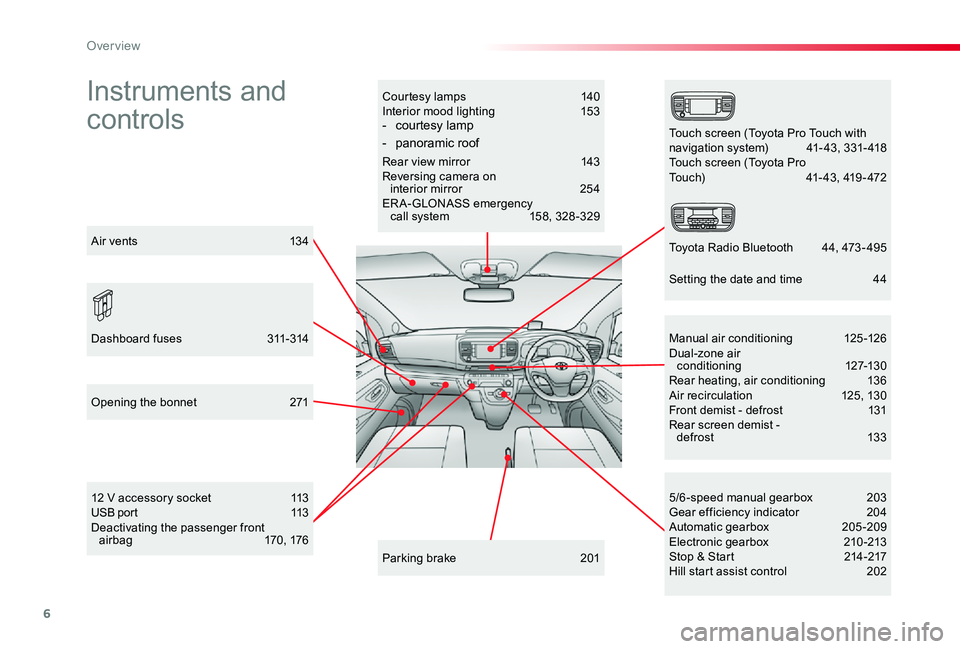
6
Instruments and
controls
Courtesy lamps 140Interior mood lighting 153- courtesy lamp
- panoramic roof
Rear view mirror 143Reversing camera on interior mirror 254ERA-GLONASS emergency call system 158, 328 -329
12 V accessory socket 113USB port 113Deactivating the passenger front airbag 170, 176
5/6 -speed manual gearbox 203Gear efficiency indicator 204Automatic gearbox 205-209Electronic gearbox 210 -213Stop & Start 214-217Hill start assist control 202
Manual air conditioning 125-126Dual-zone air conditioning 127-130Rear heating, air conditioning 136Air recirculation 125, 130Front demist - defrost 131Rear screen demist - def rost 13 3
Parking brake 201
Opening the bonnet 271
Dashboard fuses 311-314
Touch screen (Toyota Pro Touch withnavigation system) 41- 43, 331- 418Touch screen (Toyota ProTouch) 41- 43, 419 - 472
Toyota Radio Bluetooth 44, 473 - 495Air vents 134
Setting the date and time 44
Over view
Page 12 of 505

11
Eco-driving is a range of everyday practices that allow the motorist to optimise their fuel consumption and CO2 emissions.
Eco- driving
Optimise the use of your
gearboxWith a manual gearbox, move off gently and change up without waiting. During acceleration change up early.
With an automatic or electronic gearbox, give preference to automatic mode and avoid pressing the accelerator pedal heavily or suddenly.
The gear shift indicator invites you to engage
the most suitable gear: as soon as the indication is displayed in the instrument panel, follow it straight away.For vehicles fitted with an electronic or automatic gearbox, this indicator appears only in manual mode.
Drive smoothly
Maintain a safe distance between vehicles, use engine braking rather than the brake pedal, and press the accelerator progressively. These practices contribute towards a reduction in fuel consumption and CO2 emissions and also help to reduce the background traffic noise.
If your vehicle has cruise control, make use of the system at speeds above 25 mph (40 km/h) when the traffic is flowing well.
Control the use of your
electrical equipment
Switch off the demisting and defrosting controls, if not automatic.Switch off the heated seat as soon as possible.
Switch off the headlamps and front foglamps when the level of light does not require their use.
Avoid running the engine before moving off, particularly in winter; your vehicle will warm up much faster while driving.
As a passenger, if you avoid connecting your multimedia devices (film, music, video game...), you will contribute towards limiting the consumption of electrical energy, and so of fuel.Disconnect your portable devices before leaving the vehicle.
Before moving off, if the passenger compartment is too warm, ventilate it by opening the windows and air vents before using the air conditioning.Above 30 mph (50 km/h), close the windows and leave the air vents open.Remember to make use of equipment that can help keep the temperature in the passenger compartment down (sunroof and window blinds...).Switch off the air conditioning, unless it has automatic regulation, as soon as the desired temperature is attained.
.
Eco-driving
Page 14 of 505
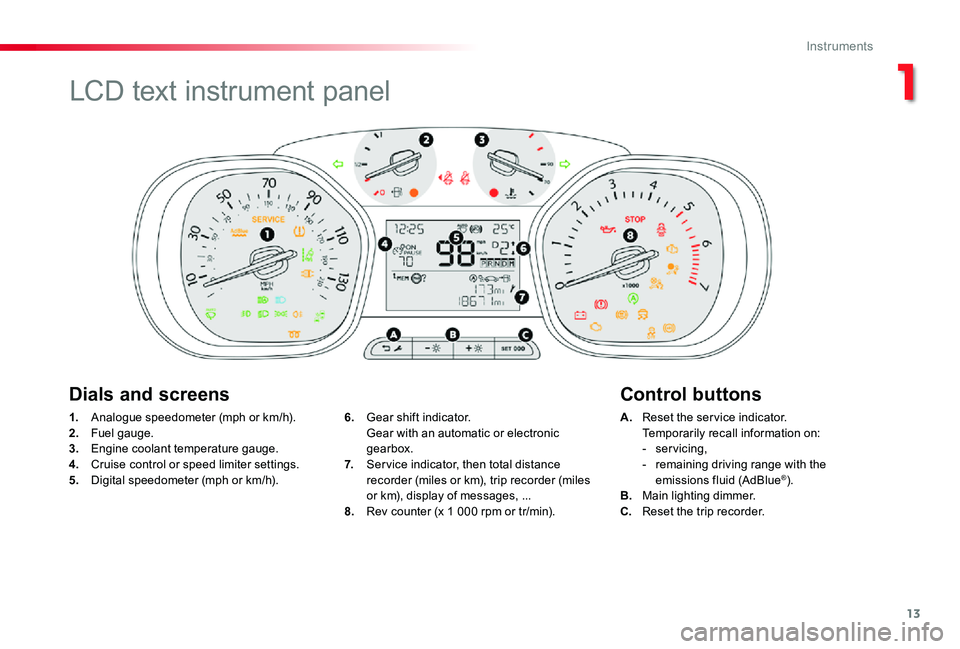
13
1. Analogue speedometer (mph or km/h).2. Fuel gauge.3. Engine coolant temperature gauge.4. Cruise control or speed limiter settings.5. Digital speedometer (mph or km/h).
A. Reset the service indicator. Temporarily recall information on:- servicing,- remaining driving range with the emissions fluid (AdBlue®).B. Main lighting dimmer.C. Reset the trip recorder.
6. Gear shift indicator. Gear with an automatic or electronic gearbox.7. Ser vice indicator, then total distance recorder (miles or km), trip recorder (miles or km), display of messages, ...8. Rev counter (x 1 000 rpm or tr/min).
Dials and screensControl buttons
LCD text instrument panel
1
Instruments
Page 15 of 505
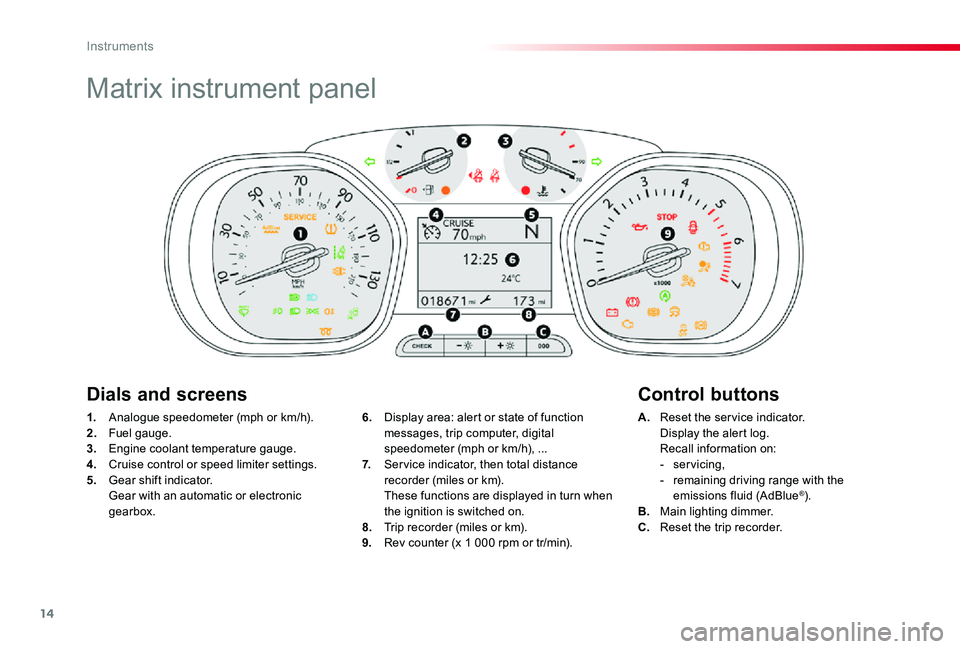
14
Matrix instrument panel
1. Analogue speedometer (mph or km/h).2. Fuel gauge.3. Engine coolant temperature gauge.4. Cruise control or speed limiter settings.5. Gear shift indicator. Gear with an automatic or electronic gearbox.
A. Reset the service indicator. Display the alert log. Recall information on:- servicing,- remaining driving range with the emissions fluid (AdBlue®).B. Main lighting dimmer.C. Reset the trip recorder.
6. Display area: alert or state of function messages, trip computer, digital speedometer (mph or km/h), ...7. Ser vice indicator, then total distance recorder (miles or km). These functions are displayed in turn when the ignition is switched on.8. Trip recorder (miles or km).9. Rev counter (x 1 000 rpm or tr/min).
Dials and screensControl buttons
Instruments
Page 20 of 505

19
Warning / indicator lampStateCauseAction / Observations
+
Engine auto-diagnosis system
fixed, associated with the STOP warning lamp.
A major engine fault has been detected.You must stop as soon as it is safe to do so.Park, switch off the ignition and contact an authorized Toyota dealer or repairer, or another duly qualified and equipped professional immediately.
Diesel engine pre-heatingfixed.The ignition switch is at the 2nd position (igntion on).OrThe "START/STOP" button has been pressed.
Wait until the warning lamp goes off before starting.Once it goes off, starting is immediate, on condition that:- the clutch pedal is pressed fully down with a manual gearbox,- pressure is maintained on the brake pedal with an automatic or electronic gearbox.The period of illumination of the warning lamp is determined by the ambient conditions (up to about thirty seconds in extreme
conditions).If the engine does not start, switch the ignition off and then on, wait until the warning lamp goes off again, then start the engine.
Engine auto-diagnosis system
fixed.The emission control system has a fault.The warning lamp should go off when the engine is started.If it does not go off, contact an authorized Toyota dealer or repairer, or another duly qualified and equipped professional immediately.
flashing.The engine management system has a fault.Risk of destruction of the catalytic converter.Have it checked by an authorized Toyota dealer or repairer, or another duly qualified and equipped professional immediately.
+
fixed, associated with the SERVICE warning lamp.
A minor engine fault has been detected.Have it checked by an authorized Toyota dealer or repairer, or another duly qualified and equipped professional immediately.
1
Instruments
Page 21 of 505
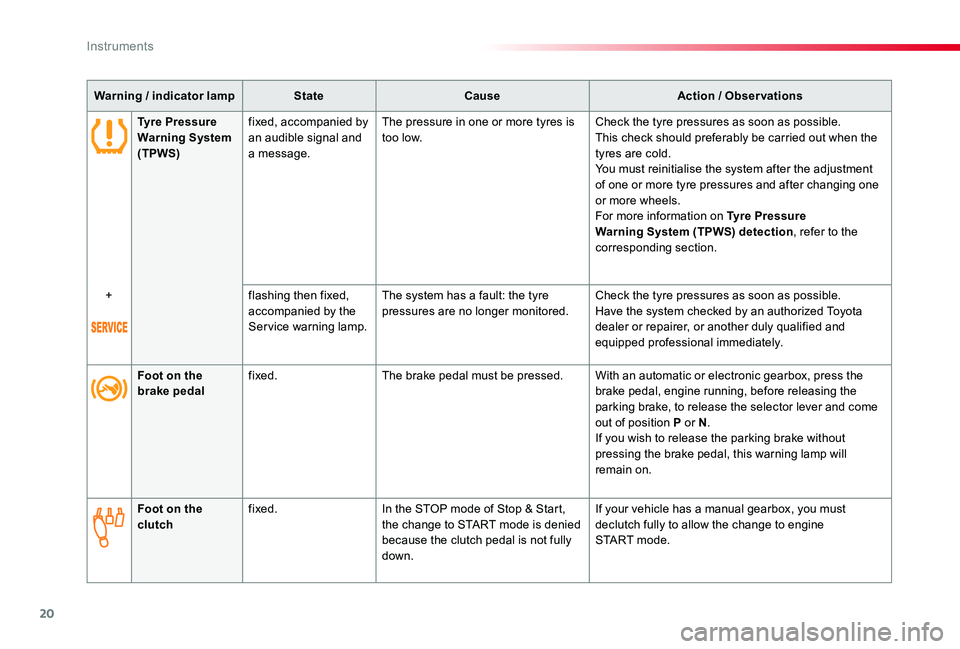
20
Warning / indicator lampStateCauseAction / Observations
Foot on the brake pedalfixed.The brake pedal must be pressed.With an automatic or electronic gearbox, press the brake pedal, engine running, before releasing the parking brake, to release the selector lever and come out of position P or N.If you wish to release the parking brake without pressing the brake pedal, this warning lamp will remain on.
Foot on the clutchfixed.In the STOP mode of Stop & Start, the change to START mode is denied because the clutch pedal is not fully down.
If your vehicle has a manual gearbox, you must declutch fully to allow the change to engine S TA R T m o d e .
Tyre Pressure Warning System (TPWS)
fixed, accompanied by an audible signal and a message.
The pressure in one or more tyres is too low.Check the tyre pressures as soon as possible.This check should preferably be carried out when the tyres are cold.You must reinitialise the system after the adjustment of one or more tyre pressures and after changing one or more wheels.For more information on Tyre Pressure Warning System (TPWS) detection, refer to the corresponding section.
+flashing then fixed, accompanied by the Ser vice warning lamp.
The system has a fault: the tyre pressures are no longer monitored.Check the tyre pressures as soon as possible.Have the system checked by an authorized Toyota dealer or repairer, or another duly qualified and equipped professional immediately.
Instruments
Page 193 of 505
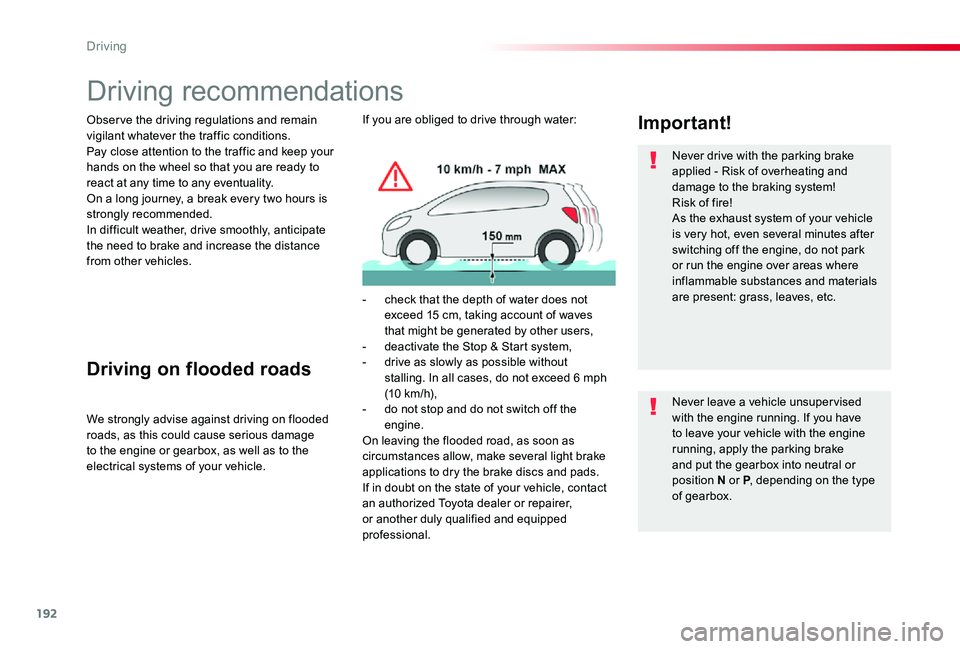
192
Driving recommendations
Obser ve the driving regulations and remain vigilant whatever the traffic conditions.Pay close attention to the traffic and keep your hands on the wheel so that you are ready to react at any time to any eventuality.On a long journey, a break every two hours is strongly recommended.In difficult weather, drive smoothly, anticipate the need to brake and increase the distance from other vehicles.
Never drive with the parking brake applied - Risk of overheating and damage to the braking system!Risk of fire!As the exhaust system of your vehicle is very hot, even several minutes after
switching off the engine, do not park or run the engine over areas where inflammable substances and materials are present: grass, leaves, etc.
Never leave a vehicle unsuper vised with the engine running. If you have to leave your vehicle with the engine running, apply the parking brake and put the gearbox into neutral or position N or P, depending on the type of gearbox.
Driving on flooded roads
We strongly advise against driving on flooded roads, as this could cause serious damage to the engine or gearbox, as well as to the electrical systems of your vehicle.
Important!If you are obliged to drive through water:
- check that the depth of water does not exceed 15 cm, taking account of waves that might be generated by other users,- deactivate the Stop & Start system,- drive as slowly as possible without stalling. In all cases, do not exceed 6 mph (10 km/h),- do not stop and do not switch off the engine.On leaving the flooded road, as soon as circumstances allow, make several light brake applications to dry the brake discs and pads.If in doubt on the state of your vehicle, contact an authorized Toyota dealer or repairer, or another duly qualified and equipped professional.
Driving